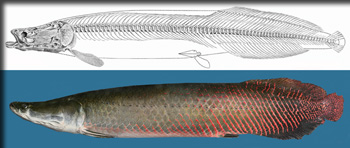(The cover of our Weedy Plants Guide!)
|
I am happy to announce that the field guide has been updated to include new flowering plant species!
Follow this link to download a free PDF of the field guide.
(The cover of our Weedy Plants Guide!)
|
 |
| Prof. Stewart with A. leptosoma. Photo credit: SUNY-ESF |
 |
| Arapaima via ESF.edu |
 Indigenous peoples have long depended on arapaima as a food source. With new knowledge of arapaima species diversity, biologists are becoming concerned about species conservation, particularly because not enough information is known regarding their spatial distribution and abundance. Charismatic mega-fauna, particularly those hunted for sport, are especially vulnerable to the threats of over fishing.
Indigenous peoples have long depended on arapaima as a food source. With new knowledge of arapaima species diversity, biologists are becoming concerned about species conservation, particularly because not enough information is known regarding their spatial distribution and abundance. Charismatic mega-fauna, particularly those hunted for sport, are especially vulnerable to the threats of over fishing.